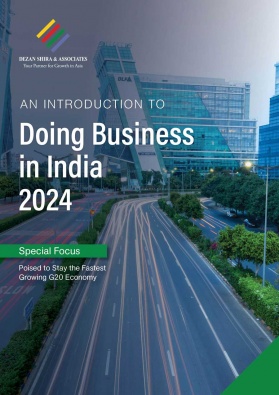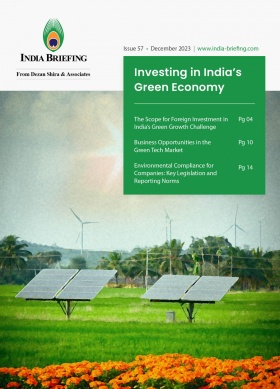India’s General Election Dates Announced, Polling Scheduled in Seven Phases
India has announced dates to its 18th general elections, during which voters will elect 543 members to the Lok Sabha, or lower house of parliament. The Election Commission of India (ECI) will oversee the nationwide voting, which will be carried out in seven phases from April to June this year.
India’s 2024 general election dates have been staggered from April 19 to June 1, per the Election Commission of India (ECI). In what is the world’s largest electoral exercise, India’s voter base of 970 million citizens, spanning 28 states and eight union territories, will vote under a seven-phase schedule.
The ECI will also conduct elections to the state legislative assemblies of Andhra Pradesh, Arunachal Pradesh, Odisha, and Sikkim during this period.
India’s sitting lower house of parliament (Lok Sabha) began its term on June 15, 2019, which is set to conclude on June 16, 2024.
2024 Indian General Election schedule
India’s three larger states – Bihar, Uttar Pradesh, and West Bengal – will see polling happen in all seven phases as voting is staggered by constituencies to ensure proper organization and security of the electoral process.
|
Polling phase |
Polling date |
States |
Total parliamentary constituencies |
|
Phase 1 |
April 19 |
Arunachal Pradesh (2) Assam (5) Bihar (4) Chhattisgarh (1) Madhya Pradesh (6) Maharashtra (5) Meghalaya (2) Manipur (2) Mizoram (1) Nagaland (1) Rajasthan (12) Sikkim (1) Tamil Nadu (39) Tripura (1) Uttar Pradesh (8) Uttarakhand (5) West Bengal (3) Andaman and Nicobar Islands (1) Jammu and Kashmir (1) Lakshadweep (1) Puducherry (1) |
102 seats |
|
Phase 2 |
April 26 |
Assam (5) Bihar (5) Chhattisgarh (3) Karnataka (14) Kerala (20) Madhya Pradesh (7) Maharashtra (8) Manipur (1) Rajasthan (13) Tripura (1) Uttar Pradesh (8) West Bengal (3) Jammu and Kashmir (1) |
89 seats |
|
Phase 3 |
May 7 |
Assam (4) Bihar (5) Chhattisgarh (7) Goa (2) Gujarat (26) Karnataka (14) Madhya Pradesh (8) Maharashtra (11) Uttar Pradesh (10) West Bengal (4) Dadra and Nagar Haveli and Daman and Diu (2) Jammu and Kashmir (1) |
94 seats |
|
Phase 4 |
May 13 |
Andhra Pradesh (25) Bihar (5) Jharkhand (4) Madhya Pradesh (8) Maharashtra (11) Odisha (4) Telangana (17) Uttar Pradesh (13) West Bengal (8) Jammu and Kashmir (1) |
96 seats |
|
Phase 5 |
May 20 |
Bihar (5) Jharkhand (3) Maharashtra (13) Odisha (5) Uttar Pradesh (14) West Bengal (7) Jammu and Kashmir (1) Ladakh (1) |
49 seats |
|
Phase 6 |
May 25 |
Bihar (8) Haryana (10) Jharkhand (4) Odisha (6) Uttar Pradesh (14) West Bengal (8) Delhi (7) |
57 seats |
|
Phase 7 |
June 1 |
Bihar (8) Himachal Pradesh (4) Jharkhand (3) Odisha (6) Punjab (13) Uttar Pradesh (13) West Bengal (9) Chandigarh (1) |
57 seats |
Data Source: Election Commission of India
The election activities in Jammu and Kashmir, however, will be conducted after the conclusion of the 18th Lok Sabha elections to provide adequate security forces in the region.
The last date for filing nominations to stand as a member of parliament (MP) is May 6 and May 9 is the last day for withdrawing candidature. The final counting of all seven phases of polling will happen on June 4, 2024.
India’s 2024 General Elections: Voter profile
- Male voters: 479 million; Female voters: 471 million
- First-time voters, aged 18 years: 18 million
- Young voters, aged between 20 and 29 years: 197.4 million
- Senior citizen voters, above the age of 85 years: 8.18 million
- Senior citizen voters, above the age of 100 years: 218,000
- Service electors: 1.90 million
- People with disability: Male = 5.26 million; female = 3.57 million; and transgender = 440
- Third gender/Transgender: 48,044
Since 2014, the Bhartiya Janata Party-led National Democratic Alliance (NDA) has won two consecutive terms to form a majority in the lower house of parliament. This year seems to be more crucial for the NDA government, as it is aiming to form a government at the federal level for the third consecutive term with an overwhelming majority of 400+ seats.
However, even as Prime Minister Narendra Modi’s BJP party has expressed confidence in securing another federal term, opposition parties are expected to give tough competition states like Himachal Pradesh, conflict-ridden Manipur, and the southern states of Telangana, Tamil Nadu, Kerala, and Karnataka.
If the BJP-led bloc wins and completes a third five-year term, Modi will be the third-longest-serving prime minister in Indian history. India’s first Prime Minister, Jawaharlal Nehru, ruled for 16 years and 9 months consecutively, while his daughter, Indira Gandhi, governed for a total of 15 years and 11 months.
Model Code of Conduct
On March 16, Chief Election Commissioner Rajiv Kumar conveyed to all political parties to strictly adhere to the Model Code of Conduct (MCC), a set of guidelines issued to regulate political parties and candidates prior to elections. Among other things, the Code bars the government, at the state and federal levels, from announcing new policy decisions. This includes barring the announcement of a project or scheme that can influence voting behavior. The MCC also states that political parties must also avoid advertising at the expense of the public exchequer or using official mass media for publicity on achievements to improve their chances of victory in the elections.
The rules range from issues related to speeches, polling day, polling booths, portfolios, the content of election manifestos, processions, and general conduct, so that free and fair elections are conducted. The MCC came into effect immediately following the announcement of the election schedule, that is, March 16, and will be valid until the elections are concluded on June 6.
The ECI has issued instructions for the enforcement of the MCC during the first 72 hours of the announcement of the election schedule and also for maintaining extra vigilance and strict enforcement action in the last 72 hours prior to the close of polls. These instructions have been issued in the form of Standard Operating Procedures (SOPs) for compliance by the field election machinery.
India’s State Assembly Elections corresponding with the General Elections
|
Name of the state |
End of term of legislative assembly |
State election dates |
|
Andhra Pradesh |
June 11, 2024 |
May 13 |
|
Arunachal Pradesh |
June 2, 2024 |
April 19 |
|
Odisha |
June 24, 2024 |
May 13, 20, 24, and June 01 |
|
Sikkim |
June 2, 2024 |
April 19 |
Data Source: PIB
The Indian elections will use electronic voting machines (EVMs) and voter verifiable paper audit trail (VVPATs) at all the polling stations.
The ECI’s procedures instruct that a single polling booth can only have a maximum of 1500 voters and thus, 1,048,202 voting booths with 5.5 million EVM machines will be set up nationwide. These will be managed by 15 million poll workers and security officers.
According to the officially released electoral rolls, as of January 1, 2024, there are 968.8 million voters nationwide, up from 896 million in 2019. There is also an increase of 1.19 percent in the number of polling places in the country.
2019 General Elections: Key outcomes
In 2019, the BJP-led NDA group secured 351 seats in the General Elections. Prior to this, in 2014, the NDA bloc had won 282 seats.
In 2019, seven national parties, 43 state parties, and 623 unrecognized political parties participated in the General Elections. Out of this, 36 parties were able to win one or more seats in the Lok Sabha. In all, about 8,054 candidates, including 3,461 independents, contested those elections. Of the 543 winning candidates, 397 were from national parties, 136 were from state parties, six were from unrecognized parties, and four were independent.
Background: India’s General Elections
India held its first elections in 1951–1952, after the country gained independence from the British Empire in 1947. Since then, the General Elections in India have been held once every five years. As a multiparty democracy, the country has about 2,660 registered political parties. It is also worth noting that political parties that have a significant footprint in a state legislature are recognized as state parties. And state parties with a significant presence in multiple states get the national party tag.
The results of Lok Sabha elections decide who gets to sit in India’s lower house of parliament, also called the House of the People. The political party or coalition that attains a Lok Sabha majority will nominate one of their elected members to serve as the prime minister. The prime minister will be entrusted with selecting ministers to serve in the cabinet. At 543 seats, the Lok Sabha has more seats than the upper house, or Rajya Sabha, which currently holds 250 seats.
Also read
- India’s Prime Minister Narendra Modi Sworn in for Third Straight Term
- In a Historic Feat, PM Modi Gets Third Consecutive Term but Opposition Slows BJP Juggernaut
About Us
India Briefing is one of five regional publications under the Asia Briefing brand. It is supported by Dezan Shira & Associates, a pan-Asia, multi-disciplinary professional services firm that assists foreign investors throughout Asia, including through offices in Delhi, Mumbai, and Bengaluru in India. Readers may write to india@dezshira.com for support on doing business in India. For a complimentary subscription to India Briefing’s content products, please click here.
Dezan Shira & Associates also maintains offices or has alliance partners assisting foreign investors in China, Hong Kong SAR, Dubai (UAE), Indonesia, Singapore, Vietnam, Philippines, Malaysia, Thailand, Bangladesh, Italy, Germany, the United States, and Australia.
- Previous Article Examining India’s State Capex Performance in 2023-24
- Next Article Queensland and India Trade and Investment Scope: Key Growth Drivers







